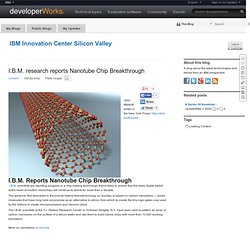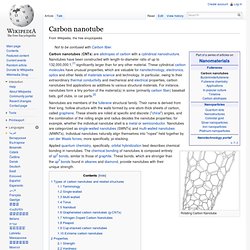

IBM's Nanotube Chip Breakthrough. I.B.M. research reports Nanotube Chip Breakthrough (IBM Innovation Center Silicon Valley) John Markoff writes in the New York Times:I.B.M.scientists are reporting progress in a chip-making technology that is likely to ensure that the basic digital switch at the heart of modern microchips will continue to shrink for more than a decade.The advance, first described in the journal Nature Nanotechnology on Sunday, is based on carbon nanotubes — exotic molecules that have long held out promise as an alternative to silicon from which to create the tiny logic gates now used by the billions to create microprocessors and memory chips.

I.B.M. research reports Nanotube Chip Breakthrough (IBM Innovation Center Silicon Valley) I.B.M. scientists are reporting progress in a chip-making technology that is likely to ensure that the basic digital switch at the heart of modern microchips will continue to shrink for more than a decade.

The advance, first described in the journal Nature Nanotechnology on Sunday, is based on carbon nanotubes — exotic molecules that have long held out promise as an alternative to silicon from which to create the tiny logic gates now used by the billions to create microprocessors and memory chips. I.B.M. Reports Nanotube Chip Breakthrough. I.B.M.

ResearchThe face of an I.B.M. research scientist, Hongsik Park, is reflected in a wafer used to make microprocessors. SAN FRANCISCO — I.B.M. scientists are reporting progress in a chip-making technology that is likely to ensure that the basic digital switch at the heart of modern microchips will continue to shrink for more than a decade. The advance, first described in the journal Nature Nanotechnology on Sunday, is based on carbon nanotubes — exotic molecules that have long held out promise as an alternative to silicon from which to create the tiny logic gates now used by the billions to create microprocessors and memory chips.
Carbon nanotube. Rotating Carbon Nanotube Carbon nanotubes (CNTs) are allotropes of carbon with a cylindrical nanostructure.

Nanotubes have been constructed with length-to-diameter ratio of up to 132,000,000:1,[1] significantly larger than for any other material. These cylindrical carbon molecules have unusual properties, which are valuable for nanotechnology, electronics, optics and other fields of materials science and technology. In particular, owing to their extraordinary thermal conductivity and mechanical and electrical properties, carbon nanotubes find applications as additives to various structural materials.
For instance, nanotubes form a tiny portion of the material(s) in some (primarily carbon fiber) baseball bats, golf clubs, or car parts.[2] Nanotubes are members of the fullerene structural family. IBM Shrinking CPU Manufacturing Process Using Carbon Nanotubes. You can currently pick up a CPU that's been designed using a "22 nanometer" process – which is to say, the width of each of the billions of tiny transistors on the chip measures far, far less than the width of a single piece of hair on your head.

That's pretty small. And IBM wants to make it smaller, but perhaps "wants" is the wrong word in this case. 2012-10-28 Made in IBM Labs: Researchers Demonstrate Initial Steps toward Commercial Fabrication of Carbon Nanotubes as a Successor to Silicon. YORKTOWN HEIGHTS, N.Y. - 28 Oct 2012: IBM (NYSE: IBM) scientists have demonstrated a new approach to carbon nanotechnology that opens up the path for commercial fabrication of dramatically smaller, faster and more powerful computer chips.

For the first time, more than ten thousand working transistors made of nano-sized tubes of carbon have been precisely placed and tested in a single chip using standard semiconductor processes. These carbon devices are poised to replace and outperform silicon technology allowing further miniaturization of computing components and leading the way for future microelectronics. Aided by rapid innovation over four decades, silicon microprocessor technology has continually shrunk in size and improved in performance, thereby driving the information technology revolution.
Silicon transistors, tiny switches that carry information on a chip, have been made smaller year after year, but they are approaching a point of physical limitation. The Road to Carbon. Ready for nanotech brains? IBM’s nanotube breakthrough gets us closer. Carbon nanotubes are tiny wires that can conduct digital computer signals at five or 10 times the speed of traditional silicon chips.

They have been around since the 1990s, but researchers have had a tough time getting them to behave. When they try to line these wires together in a useful grid as part of a computer design, the wires have a tendency to behave like wet spaghetti noodles. IBM produces first working chips modeled on the human brain. IBM has been shipping computers for more than 65 years, and it is finally on the verge of creating a true electronic brain.

Big Blue is announcing today that it, along with four universities and the Defense Advanced Research Projects Agency (DARPA), have created the basic design of an experimental computer chip that emulates the way the brain processes information. IBM’s so-called cognitive computing chips could one day simulate and emulate the brain’s ability to sense, perceive, interact and recognize — all tasks that humans can currently do much better than computers can. Dharmendra Modha (pictured below right) is the principal investigator of the DARPA project, called Synapse (Systems of Neuromorphic Adaptive Plastic Scalable Electronics, or SyNAPSE). He is also a researcher at the IBM Almaden Research Center in San Jose, Calif. IBM brings carbon nanotube-based computers a step closer.
In the effort to find a replacement for today's silicon chips, IBM researchers have pushed carbon nanotube technology a significant step ahead.

Carbon nanotubes are very small structures made of a lattice of carbon atoms rolled into a cylindrical shape, and a team of eight researchers have figured out a way to precisely place them on a computer chip, IBM announced today. That development allows them to arrange the nanotubes 100 times more densely than earlier methods, a key step in economical chipmaking, and IBM has built a chip with more than 10,000 carbon nanotube-based elements. The new technique helps improve the nanotubes' chances in the hunt for alternatives once today's silicon transistor technology runs out of steam. Solution of carbon nanotubes. On the Moore's Law hot seat: Intel's Mike Mayberry (Q&A)
Mike Mayberry, perhaps more than anyone, is the guy who keeps Moore's Law ticking.

As the vice president who leads Intel's research team, he bears responsibility for making sure his employer can cram ever more electronic circuitry onto computer chips. Intel co-founder Gordon Moore 47 years ago observed the pace at which microchips' transistor count doubled, and Mayberry is in charge of keeping that legacy intact. A lot rests on Moore's Law, which in a 1975 update to Moore's original 1965 paper predicted that the number of transistors will double every two years.
That means a chip of a given size has been able to accomplish more and more computing chores -- or that you can perform the same computing tasks using a smaller, cheaper, less power-hungry chip. Thanks to Moore's Law, the power of a supercomputer trickled down to personal computers and now to smartphones. Moore's Law: The rule that really matters in tech. Year in, year out, Intel executive Mike Mayberry hears the same doomsday prediction: Moore's Law is going to run out of steam.
Sometimes he even hears it from his own co-workers. But Moore's Law, named after Intel co-founder Gordon Moore, who 47 years ago predicted a steady, two-year cadence of chip improvements, keeps defying the pessimists because a brigade of materials scientists like Mayberry continue to find ways of stretching today's silicon transistor technology even as they dig into alternatives. (Such as, for instance, super-thin sheets of carbon graphene.) Oh, and don't forget the money that's driving that hunt for improvement.
IDC predicts chip sales will rise from $315 billion this year to $380 billion in 2016. The result: Moore's Law has long passed being mere prognostication. "If you're only using the same technology, then in principle you run into limits. IBM has developed a new carbon nanotube based chip making technology. IBM researcher Hongsik Park looks over wafer with carbon nanotubes. Researchers at International Business Machines‘ T.J. Watson Research Center in New York have made a new technology breakthrough that will help us keep transistors, the basic build blocks of our technology-infused world, getting smaller and more powerful. IBM’s 3 big chip breakthroughs explained. IBM has made three breakthroughs that could help chips continue following Moore’s Law. Monday at the IEEE International Electron Devices Meeting, IBM showed off the first racetrack memory device that delivers an entirely new means to get electrons to hold data, as well as two materials breakthroughs that could lead to faster chips and even open up new spectrum bands that would be useful for delivering mobile broadband.
Racetrack memory: IBM’s racetrack memory offers the ability to store massive quantities of information like hard drives do but has no moving parts like solid state drives do, so it’s faster. 2011-12-05 Made in IBM Labs: Researchers Demonstrate Future of Computing with Graphene, Racetrack and Carbon Nanotube Breakthroughs. Today at IEEE International Electron Devices Meeting, IBM (NYSE: IBM ) scientists unveiled several exploratory research breakthroughs that could lead to major advancements in delivering dramatically smaller, faster and more powerful computer chips. For more than 50 years, computer processors have increased in power and shrunk in size at a tremendous rate. However, today’s chip designers are hitting physical limitations with Moore’s Law, halting the pace of product innovation from scaling alone. IBM Research: Overview - United States. IBM carbon nanotube devices demonstrated in mainstream chip manufacturing process.
IBM prepares for end of process shrinks with carbon nanotube transistors. The shrinking size of features on modern processors is slowly approaching a limit where the wiring on chips will only be a few atoms across. As this point approaches, both making these features and controlling the flow of current through them becomes a serious challenge, one that bumps up against basic limits of materials. During my visit to IBM's Watson Research Center, it was clear that people in the company are already thinking about what to do when they run into these limits. For at least some of them, the answer would involve a radical departure from traditional chipmaking approaches, switching from traditional semiconductors to carbon nanotubes. And, while I was there, the team was preparing a paper (now released by Nature Nanotechnology) that would report some significant progress: a chip with 10,000 working transistors made from nanotubes, formed at a density that's two orders of magnitude higher than any previously reported effort.
IBM Labs develops 'initial step' towards commercial fabrication of carbon nanotubes.